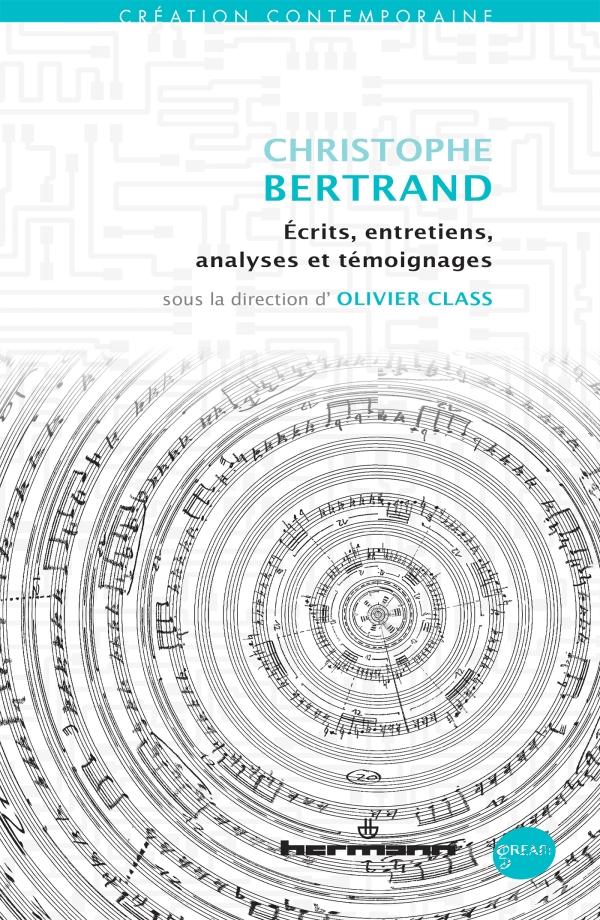CHRISTOPHE BERTRAND – WRITINGS, INTERVIEWS, ANALYZES AND TESTIMONIES
Book

| Editor: | Editions Hermann |
| Date : | 11/09/2015 |
Born in 1981, Christophe Bertrand had a dazzling career, from his entry into the computer music course at IRCAM at the end of 2000 until his premature death ten years later, at the age of 29. His work, rich in forty titles, has received numerous distinctions, and he was a resident at the Villa Medici between 2008 and 2009. But above all, his music showed exceptional maturity and expressiveness, which all the personalities of the musical world greeted her: she never left the listener indifferent.
However, Christophe Bertrand was not a revolutionary, he always denied it. The argument that you have to make new with new always made him smile. Indeed, since the second half of the 20th century, many currents have emerged, succeeded each other, or confronted each other in a particularly short period of time: serial music, spectral music, musical theatre, new complexity, minimalism, to name only those to which he referred the most. We must not forget the new technologies, which are constantly evolving, and more and more quickly.
In this particularly rich and constantly changing panorama, Christophe Bertrand did not seek to champion one school against the others, nor to reject them all on principle, as he confided in 2007 to Frans Waltmans. The year of his death, he suggested to Nikos Spiliotis that the room for development was now limited, that there was not much left to discover. This remark may seem pessimistic, even defeatist. However, there is nothing. Faced with the multitude of trends that had appeared since the end of the Second World War, he had understood that it was necessary to take the best of this legacy and mature it. He did not claim to write a reference work himself, but rather to deepen the most representative works of these different currents.
He did not promulgate a new aesthetic, he did not seek to invent new techniques or new compositional tools; nor did he have the ambition or the pretension to bring to their peak those he used, as Johann Sebastian Bach had done with Baroque polyphony. Perhaps he would have succeeded, or at least contributed to it, if he had lived longer? Be that as it may, he had studied the works of those he revered extensively, starting with the Kammerkonzert of Ligeti, of which he already had such an acute understanding at only 19 years old; not so much in the analysis he made of it as part of his composition diploma and reproduced at the end of this book, but in the appropriation he makes of it in his music. The writing in blocks of sound and the superposition of monodic lines at different speeds that he highlights in the work of Ligeti are two salient features of his own music. This is not yet very explicit in Yet, which plays on phase shifts and the entanglement of lines (other aspects of Ligeti underlined in his study) through the spatial arrangement of the musicians on stage, but will be magnified later, both by the orchestral formations of Mana, Vertigo and Okhtor, than by works with smaller numbers such as Satka.
Other composers have marked him a lot, and even more, certain emblematic works. In his interview with Nikos Spiliotis, written in English, he used the term “manifesta (manifesto), because he saw these works as beacons, opening up new perspectives that had to be matured in order not to be overtaken by these two extreme tendencies. which are, on the one hand, originality at all costs, and, on the other hand, “returns to” which he described as “intellectual regression”. Thus, in addition to Ligeti, Metastasis by Xenakis and Sinfonia by Berio had particularly marked him. He also had a lot of admiration for Steve Reich’s Music for 18 musicians, which precisely showed that diatonism was not linked exclusively to the music of the past or to “neo-” aesthetics, but that it could make “sound” the material, as is the case in Yet. He was very impressed by Gérard Grisey’s Vortex Temporum, a work in which he observed how the legacy of Ligeti and Stockhausen had magnificently borne fruit. Finally, we must not forget more classic references that he revealed in his last years: Maurice Ravel, Anton Bruckner and especially Richard Strauss.
